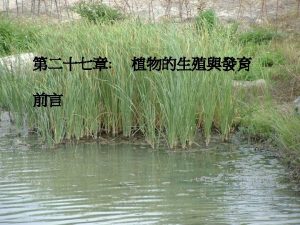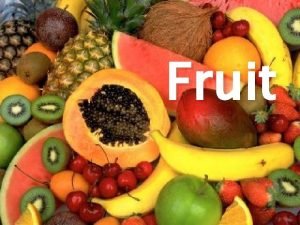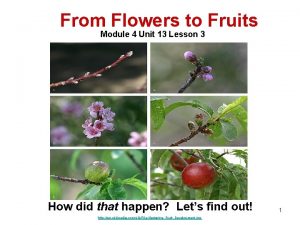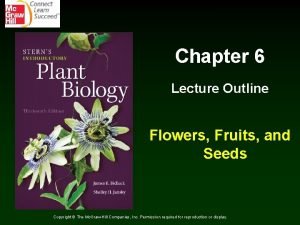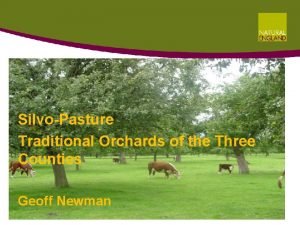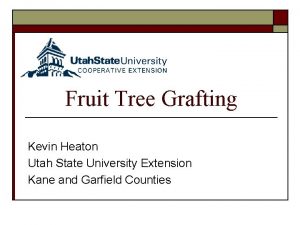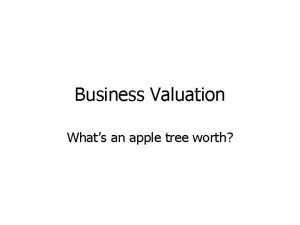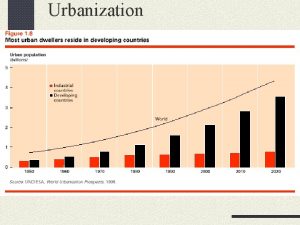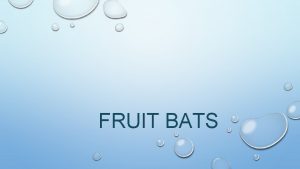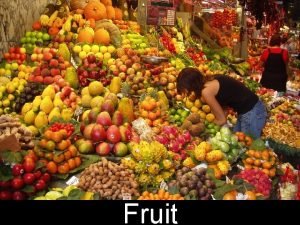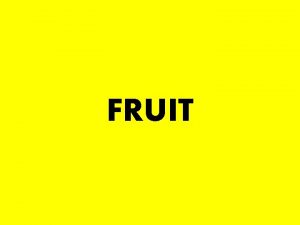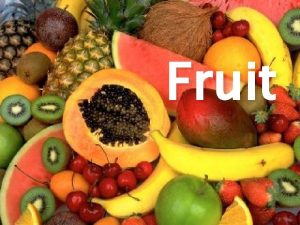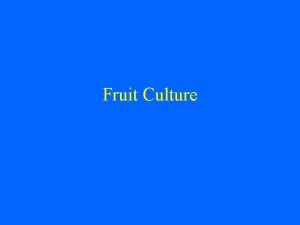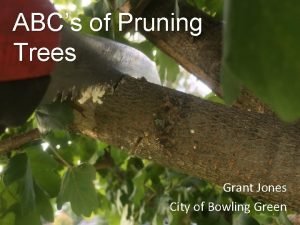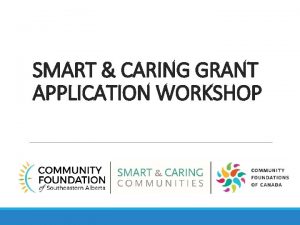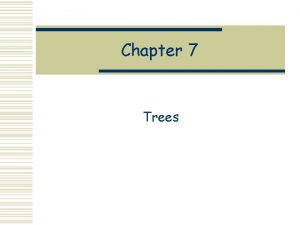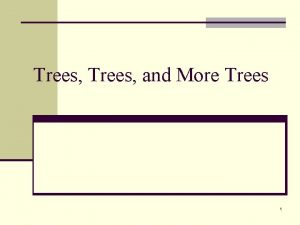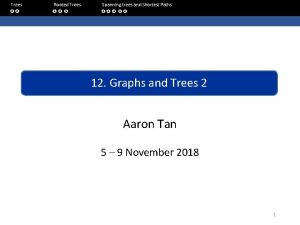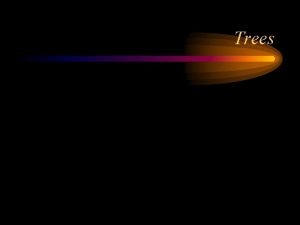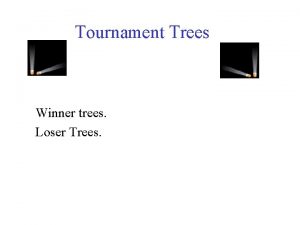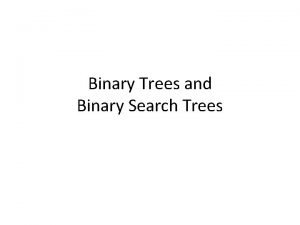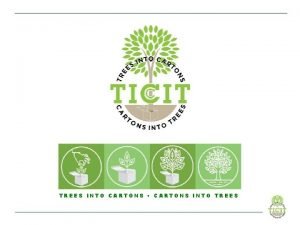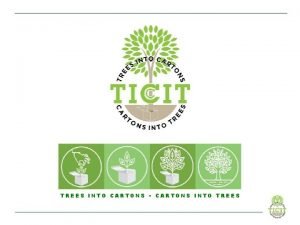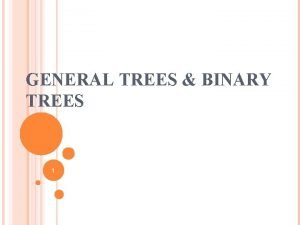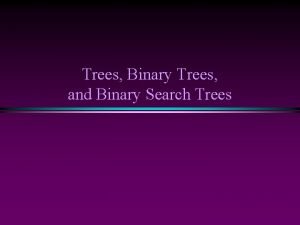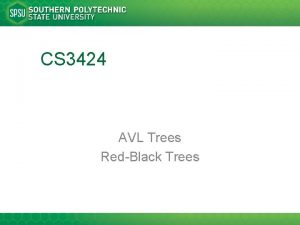Caring for Fruit Trees Grant Jones City of

























































- Slides: 57


Caring for Fruit Trees Grant Jones City of Bowling Green

Outline • • Pruning Fertilizing Pest Management Thinning Fruit

Strong union without a bark inclusion Collar

Branch Attachment Image from Up by the Roots

Included Bark

Good Branch Attachment

Proper Finishing Cuts

Closure of Pruning Cuts

Improper Cut

Types of Pruning Cuts • Thinning cut – Remove branch back to a lateral – Preferred cut in many cases • Heading back – Cutting back of current growth or one year growth – In shrubs technique may result in a lot of stem tissue and few leaves

Proper Heading Cut

Dense vs. Open Growth

Training Young Trees Peach Plum Apricot Cherry Source: Midwest Home Fruit Production Guide Apples Pears

Training Apple and Pear – Year 1 • Select 3 -4 scaffolds • Space branches • Remove shoots below first scaffold in 1 -2 years

Spacing Branches Source: New Mexico State Extension

Training - Years 2 -5 • Space branches for first 5 years • Remove unwanted shoots/branches along central leader • Eventually cut leader back to 2 year old wood for pyramidal shape

Training – Open Vase • Select 3 -4 scaffold branches • Heading cut to central leader just after selected scaffolds • Heading cut to outward lateral bud

• Mature Prune. Trees in late winter/early spring • Balance dose with vigor • Maintain form – Remove upward and downward growing branches • Allow light penetration/airflow

Overgrown Fruit Trees Source: Ravenskill Orchard

Questions to ask: Source: Ravenskill Orchard

Questions to ask: 1) Do you enjoy fruit trees Source: Ravenskill Orchard

Questions to ask: 1) Do you enjoy fruit trees 2) Does the fruit taste good Source: Ravenskill Orchard

Questions to ask: 1) Do you enjoy fruit trees 2) Does the fruit taste good 3) Are the trees in good shape Source: Ravenskill Orchard

Neglected Trees • Step 1 – Remove dead and diseased branches

Neglected Trees • Step 1 – Remove dead and diseased branches • Step 2 – Remove crossing and rubbing branches

Neglected Trees • Step 1 – Remove dead and diseased branches • Step 2 – Remove crossing and rubbing branches • Step 3 – If reducing height significantly, spread it out over several years.

Fertilizer • Soil test first • Don’t over apply N – Pruning/vigor • Pears/Apples • Annually, Only N when mature, overapplying N promotes fireblight • Cherry/Peach – Not needed if 12 -18 inches of new growth

Growing Degree Days www. oardc. ohio-state. edu/gdd/Calendar. View. asp

GDDS for Fruit Pests

Fireblight

Fireblight

Fireblight • Management: – Streptomycin, Oxytetracyclin, and copper-based fungicide may provide some protection – Sterile prune at least 8 -12 below dieback

Apple Scab • Mainly on apple • Brownish, scabby spots on leaves, premature yellowing and leaf drop • Remove leaf litter; preventative fungicides can help

Apple Scab

Apple Scab Control • Fungicide spray program – every 7 days – Products include: Sulfur, Captan • Good Sanitation • Resistant cultivars

Dormant Oil 1 -1. 5%

Identification and Life History

Brown Marmorated Stink Bug

Codling Moth

Codling Moth • Generations 2 -3 • Monitor using Growing Degree Days (GDD) and pheromone traps • Collect five moths in pheromone trap. Wait 250 GDD and apply a spray treatment • Keep monitoring and apply a second spray treatment 250 GDD after five moths are caught again within a week

Pheromone Traps • Hang pheromone traps in SE side of tree 6 feet off the ground

Other Options ½ cup molasses 2. 5 cups warm water ½ tsp dried bakers yeast Makes enough for 3 ½ gallon milk jugs • Hang from May-Aug • Refill if needed • https: //www. youtube. co m/watch? v=zn 1 huk. QICb. I • •

Brown Rot • Susceptibility: – Sweet Cherries > sour cherries – Nectarines > peaches – Apricots are highly susceptible

Brown Rot • Management: • Remove infested fruit or mummies • Fungicide sprays – 2 at bloom and 2 -3 sprays before harvest

Cherry Leaf Spot • Survives on leaf debris – good sanitation • Fungicides sprays beginning two weeks after bloom – Rotate between myclobutanil and captan at recommended label rates – Copper provides some protection

Peach Leaf Curl

Peach Leaf Curl • Host: Peach • Leaves pucker and curl. Bulges turn from green to yellow to red. White bloom develops on upper leaf surface. • Overwinters on bud scales • Copper-based fungicide prior to bud swell. Applications after budbreak are ineffective Photos from Len Burkhart

Peachtree Borer

Peachtree Borer • Most critical during the first 3 -5 years after planting • Treat bark with protectant to kill eggs when then hatch • Treat at peak emergence using pheromone traps and again six weeks later

Pesticide Basics • Softer Products – Spinosad – Horticultural/Dormant Oil – Insecticidal Soap – Neem – Pyrethrin – Sulfur/Lime

Pesticide Basics – Softer Pesticides Active Ingredient Spinosad Sulfur Copper Dormant/Horticultural Oil Neem Oil Kaolin Klay Controls Caterpillars Fungus Many insects Insects

Preharvest Interval

Fruit Thinning • Heavy fruit set reduces quality • Peaches – ¾ in size, 4 -6 inches between in peaches, 2 -3 inches pear • Apples – Space every 6 inches – Thin early

Fruit Thinning

References Midwest Home Fruit Production Guide: Cultural Practices and Pest Management Midwest Tree Fruit Pest Management Handbook

Grant Jones 419. 353. 4101 gjones@bgohio. org
 Megaspore 2n
Megaspore 2n Caring occasion/caring moment
Caring occasion/caring moment Definition of fruits and vegetables
Definition of fruits and vegetables How does a fruit form
How does a fruit form Multiple fruit vs aggregate fruit
Multiple fruit vs aggregate fruit Silvopasture upsc
Silvopasture upsc Utah state extension fruit trees
Utah state extension fruit trees Valuation of fruit trees
Valuation of fruit trees Griffin-ford latin american
Griffin-ford latin american Cbd inner city outer city
Cbd inner city outer city Primate cities
Primate cities Presentera för publik crossboss
Presentera för publik crossboss Rådet för byggkompetens
Rådet för byggkompetens Tryck formel
Tryck formel Elektronik för barn
Elektronik för barn Var 1721 för stormaktssverige
Var 1721 för stormaktssverige Densitet vatten
Densitet vatten Tack för att ni har lyssnat
Tack för att ni har lyssnat Smärtskolan kunskap för livet
Smärtskolan kunskap för livet Trög för kemist
Trög för kemist Start för skala
Start för skala Typiska novell drag
Typiska novell drag Luftstrupen för medicinare
Luftstrupen för medicinare Multiplikation uppställning
Multiplikation uppställning För och nackdelar med firo
För och nackdelar med firo Adressändring ideell förening
Adressändring ideell förening Blomman för dagen drog
Blomman för dagen drog Borra hål för knoppar
Borra hål för knoppar Bris för vuxna
Bris för vuxna Bra mat för unga idrottare
Bra mat för unga idrottare Vad är ett minoritetsspråk
Vad är ett minoritetsspråk Etik och ledarskap etisk kod för chefer
Etik och ledarskap etisk kod för chefer Publik sektor
Publik sektor Datorkunskap för nybörjare
Datorkunskap för nybörjare Mantel som bars av kvinnor i antikens rom
Mantel som bars av kvinnor i antikens rom Ellika andolf
Ellika andolf Rita perspektiv
Rita perspektiv Redogör för vad psykologi är
Redogör för vad psykologi är Ministerstyre för och nackdelar
Ministerstyre för och nackdelar Tillitsbaserad ledning
Tillitsbaserad ledning Geometriska former i förskolan
Geometriska former i förskolan Tack för att ni lyssnade bild
Tack för att ni lyssnade bild Bästa kameran för astrofoto
Bästa kameran för astrofoto Sjungen poesi
Sjungen poesi Nyckelkompetenser för livslångt lärande
Nyckelkompetenser för livslångt lärande Personlig tidbok fylla i
Personlig tidbok fylla i Mästar lärling modellen
Mästar lärling modellen Orubbliga rättigheter
Orubbliga rättigheter Jätte råtta
Jätte råtta Verktyg för automatisering av utbetalningar
Verktyg för automatisering av utbetalningar Jag har nigit för nymånens skära text
Jag har nigit för nymånens skära text Vem räknas som jude
Vem räknas som jude Kolposkopi, px
Kolposkopi, px Stig kerman
Stig kerman Sju för caesar
Sju för caesar Varför kallas perioden 1918-1939 för mellankrigstiden?
Varför kallas perioden 1918-1939 för mellankrigstiden? Vad är verksamhetsanalys
Vad är verksamhetsanalys Tack för att ni har lyssnat
Tack för att ni har lyssnat
